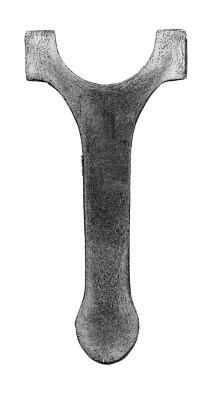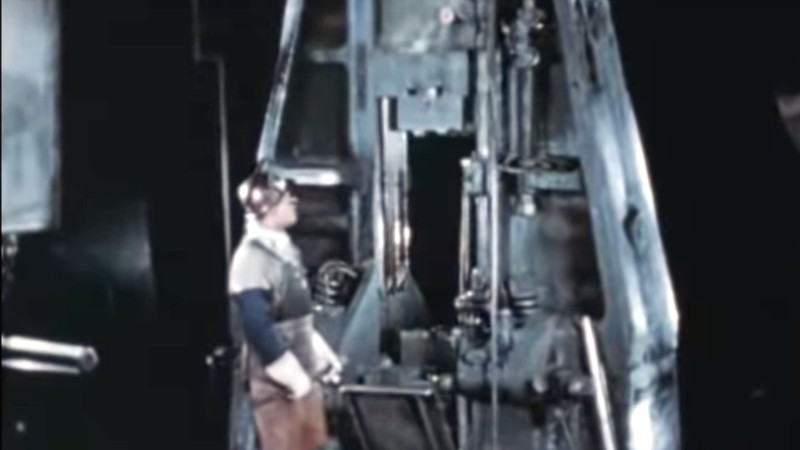It is the norm for our Retrotechtacular series to concentrate on a technology that has passed out of use but is still of interest to Hackaday readers, so it is perhaps unusual now to feature one that is very much still with us. Drop forging is a technique for forming hot metal in dies under huge force, and while it is still a current technique the 1950s educational film we are featuring is definitely retro.

If you have followed our occasional series on blacksmithing, you’ll be familiar with the process of forming metal by heating it to a temperature at which it becomes malleable enough to deform under pressure, and using a hammer to shape it against an anvil. This process not only shapes the metal, but also forms its inner grain crystal structure such that with careful management the forging process can impart significant resistance to fatigue in the finished item. Think of drop forging as automation of the manual blacksmithing process, with the same metallurgical benefits but in which the finished product is shaped in a series of dies rather than by the blacksmith’s hammer. It loses the craft of the smith over the process, but delivers an extremely consistent result along with a high production turnover.
The film that we’ve placed below the break is an in-depth introduction to the industry in a very period style and with components for the automotive, aerospace, and defense industries of the day. It takes the viewer through the different types of press and examines the design of dies to produce in stages the required grain structure and shapes.
Of particular interest is the section on upset forging, a technique in which a piece of steel stock is forged end-on rather from above. The components themselves make the video worth watching, as we see everything from jet turbine blades to medical forceps in production, along with many parts from internal combustion engines. The smallest piece shown is a tiny carburetor part, while the largest is a huge aircraft carrier catapult part that requires a special vehicle to load it into the press.
Drop forging is generally the preserve of a large metalworking factory due to the size of the presses involved. But it’s not entirely beyond the capabilities of our community given the resources of a well-equipped hackerspace or blacksmith’s shop. My father made simple forging dies by assembling a basic shape in weld and pieces of steel stock before grinding it to his requirements and heat treating. Mounted in a large rotary fly press for repetitive small scale shaping and forming tasks in ornamental ironwork, I remember bumping them out from red hot steel bar in my early teens.
This is one of those techniques that’s useful to know about in our community, because while the need to manufacture significant quantities of ornamental ironwork may not come your way too often, it’s still worth having the capability should you need it. Meanwhile the video below the break should serve to provide you with enough heavy machinery enjoyment to brighten your day.
Thanks [Ian Somers] for the tip.
















Hard by my high school was a major tool maker that ran a drop forge. All day long you could feel the vibration of wrenches being brought into the world. Thanks for the memories…
Brings back memories of my internship at a piston manufacturer. They made forged aluminum pistons for motorcycles and such. They had a one-shot process from a billet of aluminum to a machinable piston blank. The aluminum didn’t really glow like the steel in the video, but it did catch fire from the die lubricant. Often, the burning lubricant would make the piston literally jump out of the bottom die, vertically, and the forge operator would catch it in midair. The room was filled with heat treat ovens and this massive, multi-story press. It was about a zillion degrees in there, smelled like Hell, and the floor shook with every hit. It was glorious.
Thanks for the article. As a computer programmer, desk jockey, It is fun and educational to read and learn about ‘other’ disciplines out there that really make our world ‘work’. Enjoyed it and the video.
I can feel the hearing damage from here
Before hydraulics, they used gravity — perhaps that’s
where the moniker ‘drop’ comes from.
Impressive beasts:
https://en.wikipedia.org/wiki/Creusot_steam_hammer
whad’ya mean “before hydraulics”? Gravity drop forging is still in use today ;-)
https://www.youtube.com/watch?v=k7S23zQhrFo
One of the lesser-known technology races of the cold war involved hydraulic presses.
In the aftermath of WW-II Allied teams searching for Germany technology discovered that one of the Luftwaffes’ secret weapons was their ability to make huge forgings. This meant that aircraft structures, like the entire spar/gear/engine mount of the BF-109, could be made in one piece, rather than built up in sections, yielding significant weight and strength gains.
Both the US and USSR said “Yes, I’ll have some of that” and launched national programs to provide their industries with enormous forging presses.
These machines were *GIGANTIC*, in some cases generating 50,000 tons of force. Here’s a writeup on one that was declared an engineering historic landmark
https://www.asme.org/wwwasmeorg/media/resourcefiles/aboutasme/who%20we%20are/engineering%20history/landmarks/71-alcoa-50000-ton-hydraulic-forging-press.pdf
Sadly, I don’t think that many still exist, but back in the late 90’s I was working on a project down the road from the Burbank airport, and they were tearing down the buildings that had once been the original Lockheed skunkworks. One of these presses lived inside one of those buildings.
They tore down the building to build a parking lot, but there was no practical way to move the press, so they just left it there and built the lot around it. Thing must have been 30 feet tall – and I was told that this was one of the smaller ones.
https://en.wikipedia.org/wiki/Heavy_Press_Program
The US built 10 giant presses immediately after WWII, and eight of them are still in operation. None is the world’s largest anymore, but the 50,000 ton Alcoa and Wyman presses were the largest when they were new, and have been in continuous use for 60 years forging parts for most all our military aircraft.
Let”s not forget Mesta Machinery
https://en.m.wikipedia.org/wiki/Mesta_Machinery
Yeah, I was just reading about the Loewy brothers and thinking about adding a wikipedia page for them and their giant presses, while I was reading about other units in the heavy press program.
And “the Hostess with the mostest!”
B^)
A while ago I saw some photos of a massive turntable with a bridge across it. Various powered tooling could be mounted and moved along the bridge. The photo had a whole bunch of people standing on the bridge to show the size of it. Someone replied to the post telling where the thing was, and that it was still there, with the bridge removed and pushed to the side against a wall. Nobody would take it for scrap because the cost of cutting up the bridge and digging the turntable out of the ground and its massive concrete footings was a lot more than the scrap value of the metal.
A thing like that could be used to do so many things if upgraded with current technology.
Thank you for posting this.
It is interesting how the etched forgings back then show how the grain flow patterns match the sort of stress lines that FEM simulations show on parts today.
That half-wheel drawing tool was worth watching the whole film for, all by itself.
Can someone talk about lack of hearing protection? I can’t imagine anyone hearing anything after day 1 on that job.